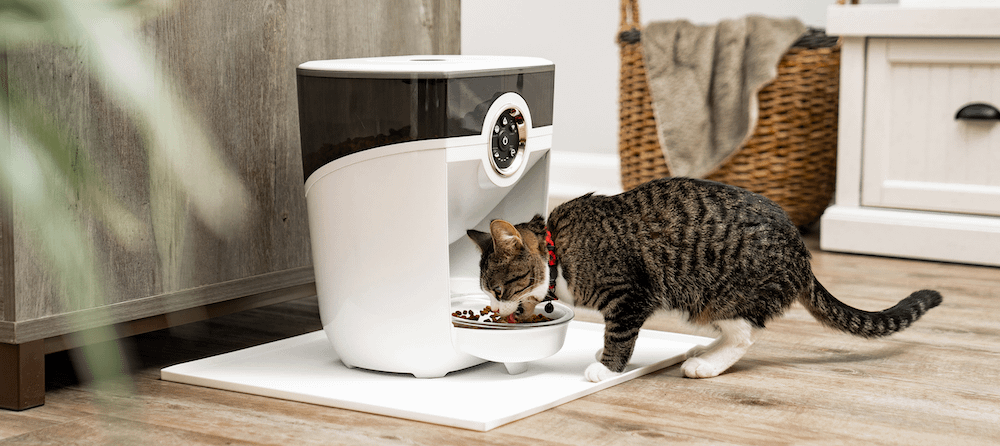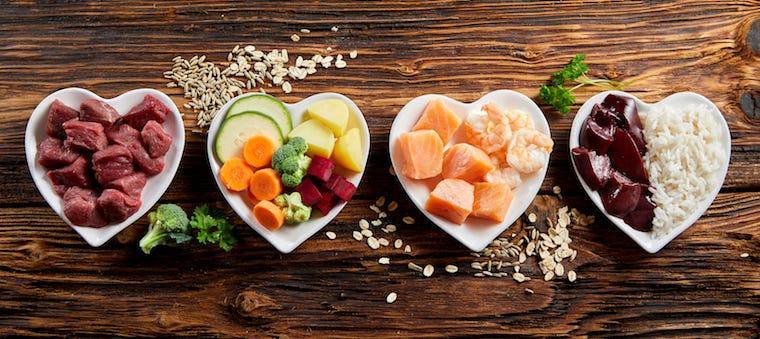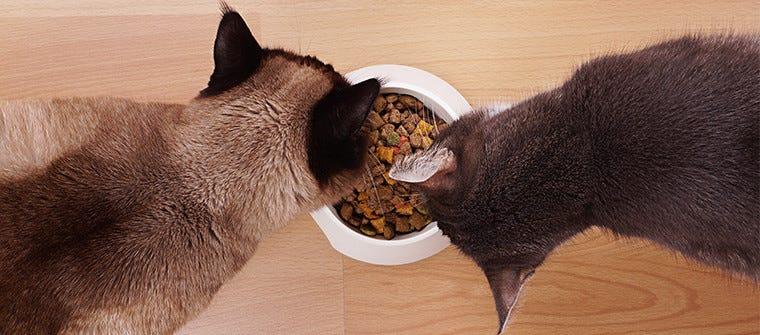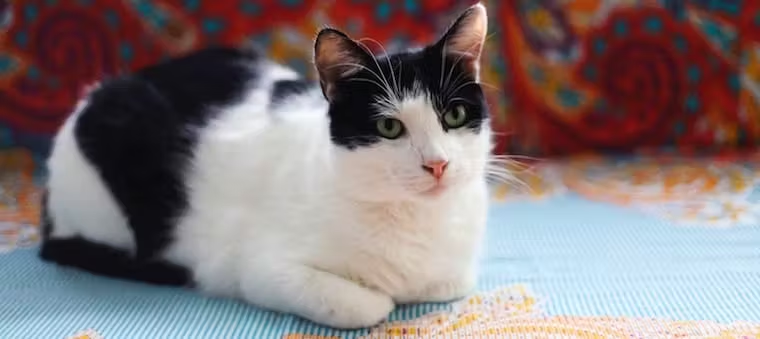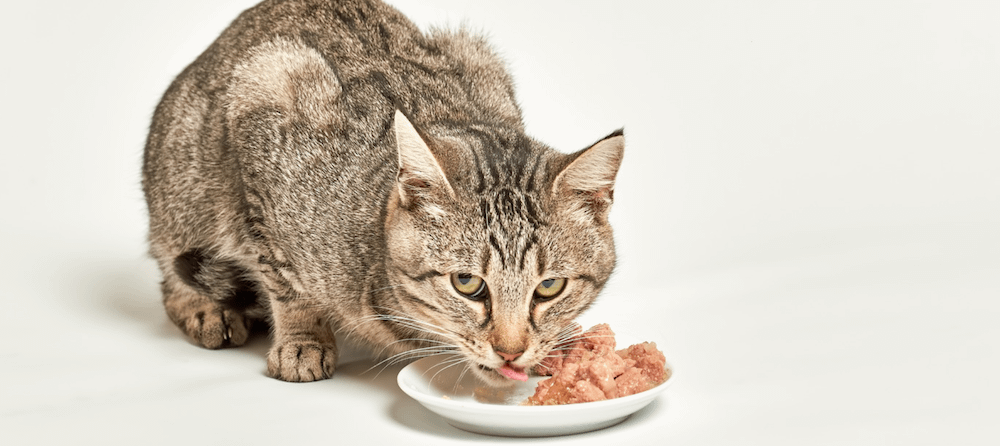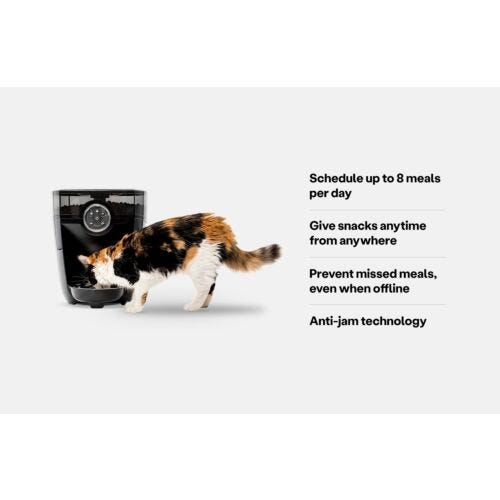Most cat parents have wondered at one time or another, How much should I feed my cat? So, how should you feed your cat? And what should you feed? And how much? These are controversial topics for both pet parents and veterinary professionals. Seems everyone has a different opinion on it nowadays.

How long can cats go without food?
A healthy adult cat can survive without food for about 1 to 2 weeks. However, it's crucial to note that the absence of food for an extended period can lead to severe health issues and, ultimately, death. Lack of food can result in the breakdown of body fat for energy, but if the fasting period is prolonged for more than 3-5 days it may lead to hepatic lipidosis, a serious liver disorder.
In general, adult cats are typically fed one to two meals per day. Kittens, on the other hand, usually require more frequent feeding, often three to four meals a day, due to their higher energy requirements for growth.
It's worth noting that some cats may prefer grazing and may do well with access to small amounts of food throughout the day. Others may be more accustomed to scheduled meals. Monitoring your cat's weight and adjusting the portion sizes accordingly can help ensure that your cat maintains a healthy weight.
Why is my cat always hungry?
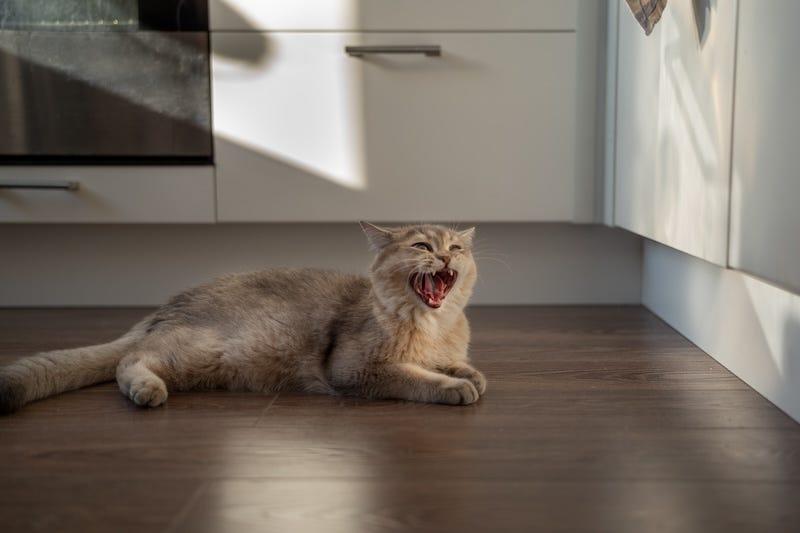
If you've noticed a noticeable increase in your cat's appetite, there are several factors worth considering. Let's delve into some potential reasons why your cat is always hungry.
Inadequate diet
Your cat's current diet may not be meeting its nutritional needs, leading to increased hunger. Cats are carnivorous, meaning their diet primarily consists of meat, and they have specific nutritional requirements. Ensure that you are feeding a balanced and appropriate cat food, and consider consulting with a vet to determine the best diet for your cat's age, weight, and health status.
Metabolic or medical issues
Conditions such as diabetes, hyperthyroidism, or other metabolic disorders can increase a cat's appetite. Hyperthyroidism, for example, can lead to an increased metabolism and, consequently, an increase in appetite. This condition is often associated with weight loss.
Parasites
Worms or other parasites can affect a cat's digestive system and nutrient absorption, causing an increased appetite. There are steps you can do at home to help diagnose whether your cat has worms but ultimately regular veterinary check-ups and deworming are the best ways to address this issue.
Boredom or anxiety
Environmental factors play a role as well. Boredom or stress can lead to overeating. Providing environmental enrichment, playtime, and mental stimulation can help alleviate boredom and treat anxiety in cats.
Pregnancy or nursing
If your female cat is pregnant or nursing, she may experience an increase in appetite to support the energy demands of these processes. Tell-tale signs that your cat is pregnant include weight gain, swollen abdomen, vomiting, and change in nipple appearance.
Should you observe persistent changes in your cat's eating habits, a veterinary consultation is advised. Through a systematic approach, veterinarians can address and mitigate these concerns, ensuring the continued health and well-being of your cherished feline companion.
How much should I feed my cat?
OK, the most important question. How much should you feed?
In general, adult cats require 20 kcals per pound of cat. Which means your healthy adult, 10-pound cat should eat 200 calories a day.
However, recent estimates from the association for pet obesity prevention show that 61% of cats in America are overweight to obese! In fact, according to the study, nearly one third of owners with overweight or obese pets (BSC 6-9) think their pet has a normal, ideal weight, or is thin.
Please keep in mind that obesity predisposes cats to so many medical problems; obese cats are 4.5x more likely to develop cat diabetes, 7x more likely to develop musculoskeletal problems, and 2x as likely to die at a younger age.
How much to feed a cat chart
Factors such as age, weight, activity level, and health status play a crucial role in determining the appropriate amount of food for a cat. Figuring out how much to feed a kitten for example can be tricky as they have varying nutritional needs as they grow. Senior cats might require adjustments based on potential health issues or reduced activity levels.
| Cat Type | Daily Caloric Intake | Dry Food (grams/cups) | Wet Food (grams/ounces) |
| Kitten (Up to 6 months) | 2x to 3x Adult Intake | 1/4 to 1/3 cup (50-75g) | 2.5 to 3.5 ounces (75-100g) |
| Adult (1 to 7 years) | 200-300 calories | 1/3 cup (40-60g) | 3.5 ounces (100g) |
| Senior (7 years and older) | 180-220 calories | 1/4 cup (30-40g) | 3 ounces (85g) |
Note that these are general guidelines for a healthy 10 pound adult cat, and individual cat needs may vary. Always consult with your veterinarian for personalized advice based on your cat's specific requirements.
Additional factors impacting how much to feed a cat
Additional factors impact how much to feed a cat, and it's essential to consider these variables to ensure your cat receives the appropriate nutrition for their individual needs. Here are some key factors:
- Weight: A cat's weight is a crucial factor in determining their food intake. Overweight and underweight cats may require adjustments in portion sizes to maintain a healthy body condition.
- Activity levels: More active cats burn more calories. Outdoor cats or those engaged in vigorous play may need additional calories compared to sedentary indoor cats.
- Breed: Some breeds may have specific nutritional requirements. Large breeds, for example, may have different needs compared to smaller breeds.
- Body Condition: Regularly assess your cat's body condition by feeling their ribs. Adjust portion sizes to maintain an ideal body condition score.
Common mistakes
The biggest mistake I see? People feeding for the current weight of their cat. If you follow the directions for feeding a 14-pound cat, but your cat’s ideal body weight is really 10 pounds, you’re overfeeding! You should be feeding for a 9-pound cat to help them potentially lose weight. (When in doubt, consult with your veterinarian about establishing a safe weight loss plan for your cat.) As a veterinarian, I can likely tell the majority of cat parents to reduce the amount they are feeding by 25% right now! (No go, if your cat has kidney disease, hyperthyroidism, cancer, etc., though!)
Combining dry and wet food
As for the exact amount to feed if you are combining both dry and wet food? It’ll depend on the brand. And type (e.g., canned versus dried, etc.). And again, your cat’s ideal body weight. As a veterinarian and cat parent, it drives me bonkers that the pet food industry doesn’t label their product better—how many calories are in a can or a cup of food?! While I can find the information, I have to research it EVERY. SINGLE. TIME.
When mixing dry and wet food, the general rule that I stick by is approximately 1/4 cup of dry food twice a day for adult cats, and approximately 1/4-1/2 can of canned food (grueled with more water) as a snack.
Kittens typically require feedings 3-4x/day; consider weaning them to an adult cat food around 6-8 months of age. Make sure that you’re feeding your cat the right amount of food with an automatic cat feeder like Feeder-Robot, which allows you to program the correct portion size, helping to avoid overfeeding.
What should I feed my cat?
What about what to feed? I’m personally a big advocate for both dry food and wet food. A complete and balanced, AAFCO-approved cat food by a research-based pet food company is a must. With all the recalls out there, I want to make sure it’s a safe product that is frequently analyzed and tested. Also, because cats have very specific amino acid requirements that they must get in their diet (e.g., taurine), it’s really important that the diet be AAFCO-approved or created by a veterinary specialist in nutrition. (You can find a Diplomate of the American College of Veterinary Nutrition or “DACVN”, which is a board-certified veterinary nutritionist.
So, when it comes down to it, many vets, including me, will tell you to combine both dry and canned food.
Canned food contains 60-80% water and requires less carbohydrates (versus kibble, which has a higher carbohydrate amount to physically make the dry food into a kibble shape). Keep in mind that when you’re buying wet food, you’re paying more for water; that said, it helps keep your cat’s kidneys happier long-term.
If your cat has a delicate water balance due to diabetes mellitus, hyperthyroidism, chronic kidney failure, feline lower urinary tract disease (FLUTD), feline urinary obstruction, etc., canned food is a must.
Diets to skip
Because of a cat’s unique amino acid requirements (they can develop dilated cardiomyopathy and other medical problems with amino acid deficiencies), I don’t recommend vegetarian or vegan diets in cats.
I’m also not a huge fan of raw food diets in cats, as they aren’t balanced and can carry dangerous bacteria which can occasionally spread to your two-legged family members.
As for home-cooked diets? I can’t even cook for myself, but if you want to do that, make sure it’s DACVN-approved.
When in doubt, my general rule about feeding cats? Feed a cat food that your veterinarian would feed too!
How should I feed my cat?
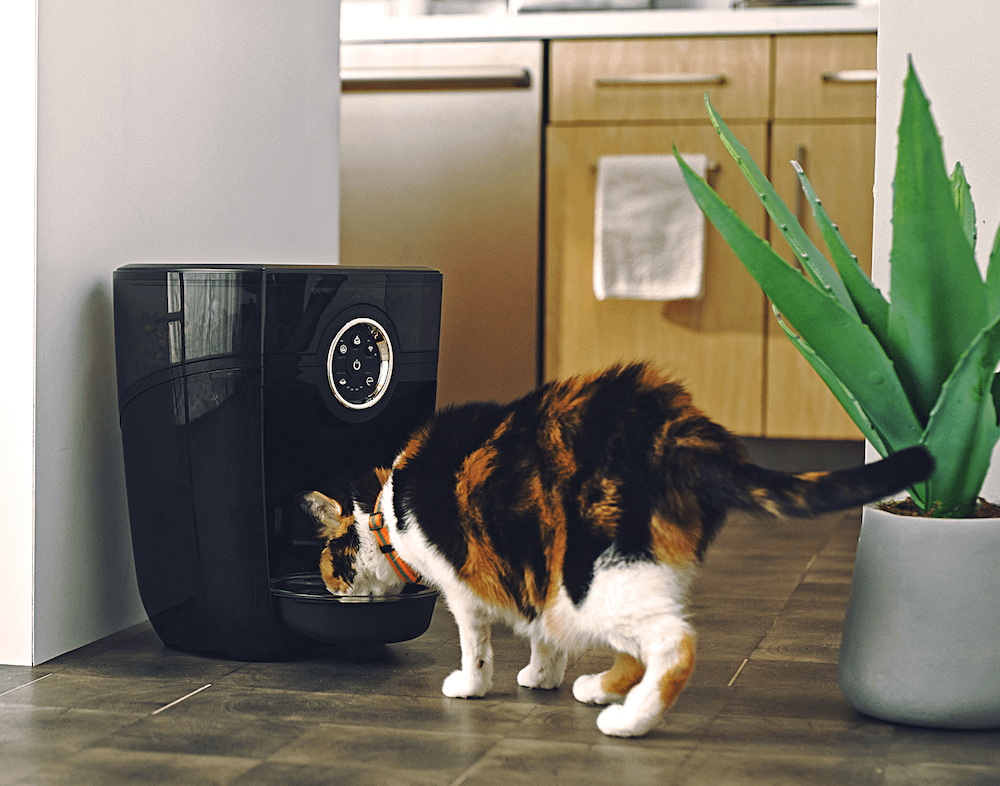
When it comes to how you should feed your cat, there are three general styles that you can implement: meal feeding, free feeding, or combination feeding.
Meal feeding
With meal feeding, that means that you are offering food several times a day in the canned and/or wet form. This type of feeding will depend on your lifestyle and preferences.
Pros
The benefits of meal feeding are that you can carefully monitor how much your cat(s) are eating.
Cons
The cons? If you business travel frequently, this will be more difficult without an automatic cat feeder or a pet sitter stopping by twice a day. Plus, if you’re feeding 2-3 times a day, you may find your cat begging for food in between. Personally, I have a very low tolerance for my cat meowing at me for food at 5 a.m.
Free feeding
Free feeding is when large amounts of dry food are left in a feeder, available for 24/7 access. With free feeding, it means that your cat has food available all the time.
Pros
I’ve personally implemented this type of feeding of dry food in all my cats since they were kittens, and because they always have access to dry food, they have learned not to become “gorgers.” As a result, my cats can pace themselves and maintain their body weight well.
Cons
The bad news about free feeding? If you haven’t tried this before, your cat may overeat and become very, very, very obese. It’s also really hard to monitor how much your cat is eating, so for me, this is a “no go” for any cat with a medical problem (e.g., fatty liver, hyperthyroidism, kidney disease, inflammatory bowel disease, etc.).
Another similar option to free feeding? Consider using a feline food puzzle that provides your cat some environmental enrichment at the same time while they “hunt” and work for food.
Combination feeding
Combination feeding is when you free feed dry food but offer canned food as a supplement. I do this for my cats. Why? Because I always want my cats to eat some wet food! (You’d be surprised how many cats I meet in the veterinary hospital that only prefer dry food.)
Pros
I purposely train my cats (when I adopt them) to start liking canned food as soon as possible, because a cat’s hydration status is really important. (In fact, hydration is so important in cats that Purina just released a new product to help cats hydrate better.) My own cat who had chronic kidney failure was fed a grueled-down canned food snack with additional warm water to help increase his water intake. (He lived to the ripe old age of 19 before succumbing to cancer.). So, please keep in mind that the extra canned food as a snack is a plus.
Cons
The cons of combination feeding? You have to monitor your cat’s weight really carefully, as they can get very obese with this “extra” food. (Remember, extra food does not equate to loving your cat more!).
Using an automatic cat feeder
Automatic pet feeders can help you control how much food your cat gets each day without having to do complicated measures.
Pros
Cat feeding robots can dispense food at scheduled times, providing a consistent feeding routine. This helps regulate your cat's eating habits, which is particularly beneficial for those on prescription diets or weight management plans and even helps reduce anxiety in cats as a feeding robot can provide a sense of routine and predictability, promoting a calmer environment.
Plus, many automatic feeders allow you to pre-set portion sizes. This feature helps prevent overfeeding or underfeeding, assisting in weight management and maintaining a healthy body condition for your cat.
Cons
If there is a power outage, some automatic feeders may not function as intended. Pets might miss meals, especially if the outage occurs during scheduled feeding times.
There may also be challenges in multi-cat households where one pet may monopolize the feeder or steal another pet's food. We recommend reading our guide on managing multi-cat households to best provide an efficient solution for owning and feeding multiple cats.

